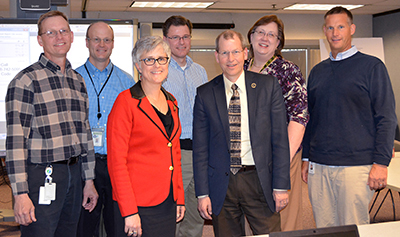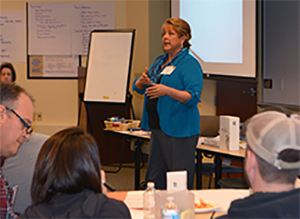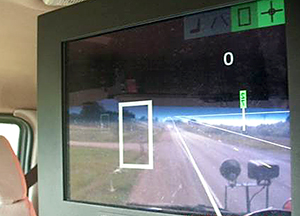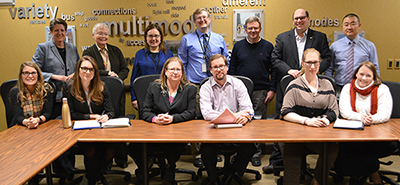 |
|

|
 |
TABLE of CONTENTS
 |
Asset Management Team completes project, institutionalizes work |
By Jocelyn Stein, EFE project management team

The Asset Management battle team included (for left to right) team leaders Dave Solsrud and Mark Nelson, coach Susan Walto, team leader Todd Stevens, champion Tim Henkel and team leader Bev Farraher, and Mark Panek, team leader. Photo by Rich Kemp |
On Jan. 13, after more than two years of hard work by many MnDOT employees, the Enhancing Financial Effectiveness Asset Management Battle officially wrapped up its project and operationalized the team’s work. Over the life of the project, the team set up new structures and systems to determine life cycle costs for MnDOT’s major assets on an ongoing basis. Additionally, the team trained hundreds of Operations and Maintenance staff to complete more detailed time reporting to enhance MnDOT’s asset management data collection. This allows MnDOT to produce more thorough reports to improve decisions on how and where to make investments.
Dave Solsrud, Asset Management Project manager, reported at the final EFE Quarterly Report Out on Jan. 28. A WIG Asset Team was established for each of four major asset types: bridge, pavement, culverts and overhead sign structures, and tower lights. The team was charged with determining information needs, developing processes, technologies, training and culture change necessary to implement resource tracking to achieve the project goals. New resource demand models were created for each of the four asset types. Resource demand models are basically formulas used to forecast MnDOT's labor, equipment and materials needs in the future. They are directly related to predicted infrastructure condition, and show that if capital investments don’t keep up, for example, more demands will fall into maintenance areas.
The Asset Management battle’s work will be operationalized by the newly formed Asset Management Team.
“I really want to thank all MnDOT employees at all levels who were involved in the Asset Management work over the past two years,” said Solsrud. “Their vision, direction, support, leadership and lots of hard work made the Asset Management Battle results such a success.”
A recognition and planning event is planned for early March for team members to celebrate their accomplishments.
“We want to ensure that the gains made are not lost as we pass the project completion milestone,” Solsrud said. “It’s important to solidify our practices in the whirlwind of what we do in our everyday work lives.”
Tracy Hatch, deputy commissioner, chief financial officer and chief operating officer, complimented the commitment and hard work of all employees involved with the EFE WIG effort.
“This is a testimonial to the passion and commitment of our employees and all the good work they do,” Hatch said. “We should all feel very proud of the work we’ve accomplished though the EFE WIG, and the asset management battle has made a significant contribution to our overall results that will be used for decades to come.”
“None of this was a brand new concept,” said Hatch. “We provided management support and resources so our employees could do those projects that had been set aside. My hat is off to everyone who was involved in this process. As we go into WIG 2.0, we will bring even stronger connections to customer service and overall performance measures. This is not the end—this is only the beginning.” |
 |
|

|
 |
TABLE of CONTENTS
 |
WIG 2.0 training for coaches kicks off |
By Nancy Bennett, EFE project management team

AnneMarie Burgess, state program manager for WIG/EFE, led the 4DX coaches in a training session held Tuesday, Feb. 16. Photo by Judy Jacobs |
Lessons learned are a big take-away from Enhancing Financial Effectiveness, WIG 1.0. One of these lessons is that all areas need someone closer to their office/district/team to help them successfully use the 4 Disciplines of Execution process and to be available to coach them when issues arise and when report-out time nears.
Seventy-five of the 78 coaches from all across MnDOT have been designated, and participated in a kickoff event Feb. 16 in St. Paul.
AnneMarie Burgess, state program manager for WIG/EFE, led the coaches through their roles, provided an overview of the 2.0 development and launch timelines, and provided them with an understanding of group dynamics and resources available to them.
“The preparation for WIG 2.0 was incredible for two very important reasons,” said Burgess. “First, the tremendous success MnDOT had with EFE resulted in policy changes and implementations that will benefit us all in the years to come. And, secondly, training is in place so that WIG 2.0 rolls out smoothly statewide.” |
 |
|

|
 |
TABLE of CONTENTS
 |
Winter safety video focuses on driving near snowplows |
This video focuses on safely driving near and around snowplow operations and how to drive in winter conditions. The video was produced in conjunction with the Work Zone Safety Awareness Program. Video produced by Video Services |
|
 |
|

|
 |
TABLE of CONTENTS
 |
Driver Assist System helps snowplow operators navigate in tough conditions |
By Sue Roe

Darryl Oeltjenbruns, snowplow driver in District 7, operates the only driver assist system, or DAS, equipped snowplow in the state. The system helps snowplow operators see road alignments and features such as turn lanes, guardrails and road markings. Photo by Chase Fester |
Take a quick look at a wind speed map and it’s easy to see that southwest Minnesota has the highest average wind speeds in the state. That’s good news for the companies who erect wind turbines, but bad news for MnDOT snowplow operators who often drive in low-visibility conditions to clear roads.
“We have more days when the wind blows than when it doesn’t,” said Chase Fester, District 7 transportation operations supervisor. “We struggle with the wind.”
That’s why District 7 is piloting a snowplow driver assist system to combat the blowing snow and fog that often cause zero visibility. The DAS helps snowplow operators see road alignments and features, such as turn lanes, guardrails and road markings. Even in less extreme winter weather, snowplow operators gain assurance of their lane location using the system.
The DAS uses GPS technology and a front-mounted radar to provide an image of the road and any obstacles in front of the operator. The image is displayed on a monitor inside the cab of the plow. The system also vibrates the operator’s seat as a warning if the plow veers too close to the roadway’s centerline or fog line.
“If the driver gets within one foot of the fog line on the right side, the right side of the seat vibrates. If the driver gets too close to the centerline on the left side, the left side vibrates,” said Fester.
The vibrations continue until the driver moves back into the center of the lane. The driver can also turn off the warning feature to clear snow from the shoulder.

The driver assist system displays a white box on the screen when an obstacle, or in this case a mailbox, is located. If the object appears in the lane, such as a car stuck in a snow drift, the box turns red and gets bigger as the snowplow gets closer to the object. Photo courtesy of District 7 |
The system is used on the same computer in the plow that contains the Automated Vehicle Location system, which uses GPS and cellular communications to track locations of trucks. Using the same computer also reduces hardware costs and space usage in the cab. The AVL system is used in more than 600 MnDOT snowplows throughout the districts.
The DAS is also tied into the Continuously Operating Reference Stations, a network that collects and continuously updates real-time data from the Global Navigation Satellite System. The CORS network is used by surveyors, engineers, landscapers, utility locators and others to pinpoint geographic locations. (See related Newsline story about CORS).
The DAS is currently installed in one truck in District 7. The $75,000 cost makes it difficult to install in every truck in the district or state, although having at least one system in every district may be possible.
Fester said the system proved its worth last week when blizzard conditions caused zero visibility and forced many road closures in southwest Minnesota. He was called out at 2 a.m. Feb. 8 to assist a stranded state trooper and several motorists on a 12-mile stretch of Hwy 60 between Windom and Heron Lake. Fester drove a pickup behind the DAS-equipped snowplow, driven by Darryl Oeltjenbruns, to reach them.
As the DAS identified stranded vehicles on the way to Heron Lake, Fester and Oeltjenbruns checked to make sure they weren’t occupied with people. Once they made it to Heron Lake, they stopped at the community center, where the state ptrooper and the stranded motorists he brought in were.
On the way back to Windom, Fester and the state patrolman continued to check on stranded vehicles as the DAS-equipped snowplow led the way. If the vehicles weren’t in the ditch, motorists drove behind the two MnDOT vehicles. If their vehicles were in the ditch, motorists rode in a Suburban that was also being escorted to Windom. After returning to Windom, the motorists were dropped off at motels or truck stops.
“When we first went out, there were about six stranded vehicles. Coming back from Heron Lake, there were about 15,” Fester said. “At one time, we had 12 vehicles in line as we drove back to Windom, driving about 10 to 15 miles per hour.”
Later that morning the DAS system was used again to locate other motorists.
“We continued to use it until about 10 a.m. or 11 a.m. that day,” Fester said. “The system worked great and kept everyone safe. It was an interesting morning.” |
 |
|

|
 |
TABLE of CONTENTS
 |
New system aims to take guesswork out of winter maintenance operations |

Metro District is helping develop a system that uses traffic data to automatically determine when road conditions have recovered from a snow storm. Photo by David Gonzalez |
By Mike Foley, Research Services & Library
Once snow flies on Minnesota roadways, MnDOT snowplow drivers get to work to clear the road and keep traffic moving. But determining when it’s OK to take plows off a road following a storm can be tricky.
Right now, maintenance crews rely on visual inspections to estimate when roads will be clear of ice and snow – a measurement commonly referred to as “time to bare pavement.” But results from a recent MnDOT-sponsored research project suggest that analyzing traffic data may be a more accurate and less costly way to gauge the progress of maintenance operations.
Researchers developed an alternative process that uses existing traffic detectors on freeways to determine when traffic flow patterns have returned to normal, and successfully tested the software system on two Twin Cities routes.
“Other states have tried to improve how they identify bare-lane regain times, but using traffic data to determine it is cutting-edge,” said Tom Peters, Research and Training engineer. “We’re at the point where we have a higher confidence level in the data-driven approach than we do in human detection.”
University of Minnesota Duluth civil engineering professor Eil Kwon is leading the project that he believes can take the guesswork out of assessing traffic conditions during winter weather events.
“For quite a few years, MnDOT snowfighters have been reporting their performance through a visual review of the roadway conditions,” said Steve Lund, state maintenance engineer and director of the Office of Maintenance. “Our snowfighters have a tough job. Automating the performance reporting will remove that task from their duties.”
In the first phase of the research project, researchers developed a prototype process that uses data on traffic speed, flow and density collected by loop detectors in the Twin Cities metro area to estimate the point at which traffic patterns return to normal — an indicator that the roadway surface has “recovered.” In a newly published second study, researchers further analyzed the traffic flow patterns during snow events under normal and snow conditions, and refined the earlier prototype into a traffic data-based measurement process for snow operations.
“We found that by comparing the variation patterns in traffic flow during a snow event with those during normal weather conditions, we could successfully identify the recovery status of the traffic flow at a given location,” Kwon said.
The researchers developed an alternative measure of performance, called the Normal Condition Regain Time, to the traditional “time to bare pavement” measurement used to gauge the progress of maintenance operations during a winter weather event.
One advantage of the new process is it can reflect how road surface conditions affect traffic flow differently during day and night periods.
“Nighttime traffic flow patterns are substantially different from those during daytime periods,” Kwon said. “We identified normal traffic patterns separately for daytime and nighttime conditions to account for these differences in estimating the recovery status.”
The Metro District currently is leading a third phase of research to develop an operational version of the system, which will analyze and improve winter maintenance operations on a daily basis across the Twin Cities freeway network. In the future, MnDOT may investigate the possibility of expanding the system statewide.
Check out the project website for more information.
This article was adapted from an online story on MnDOT Research Services’ blog, Crossroads. |
 |
|

|
 |
TABLE of CONTENTS
 |
What’s new on the web |

Members of the Office of Chief Counsel include (front row from left) Wendy Surprise, administrative assistant; Kristin White, associate legal counsel; Susan Berndt, partnerships and delegations coordinator; Ryan Gaulke, associate legal counsel; Tara Kalar, associate legal counsel; and Angie LaGrone, associate legal counsel. (Back row from left) Laura Nehl-Trueman, associate legal counsel; Nancy Melvin, policy manager; Beth Scheffer, associate legal counsel; Charles Stech, assistant records manager; Jim Cownie, assistant chief counsel; Josh Root, associate legal counsel; and Steve LaPierre, senior legal counsel. Photo by Rich Kemp |
Office of Chief Counsel
The Office of Chief Counsel announced its newly redesigned iHUB website, which went live Feb. 3. The expanded site allows the office to better connect with MnDOT customers and more effectively share legal, policy and records management tools with MnDOT staff.
The goal is to bring useful resources and information to the department. The Office of Chief Counsel employs 22 staff in a wide variety of roles and provides legal advice and assistance to all MnDOT offices and districts. The new website highlights the assorted services the office provides, including offering legal advice and guidance on:
- Writing, interpreting and enforcing contracts and addressing claims related to highways, other modes of transportation, buildings, and professional and technical services
- Writing and adopting agency rules
- Agency administrative hearings
- Writing legislative bills on transportation subjects
- Complying with the Minnesota Government Data Practices Act and responding to requests for information
- Environmental and water issues
- Coordinating with the Office of the Attorney General, which represents the department when it is sued or threated with legal action
- Agency policies are written and implemented lawfully and efficiently
- Agency records management program
In addition, the site provides quick ways to contact staff, helpful links to legal resources, and a form you can use to request legal, policy and records services.
New look for District 6 and District 7 web pages
You may have noticed minor updates to the way that news, projects and public involvement content is presented on District 6’s and District 7’s web pages. The goals were to sort information by area, to reduce confusion with more streamlined navigation, and to better focus on the content recommended most by viewers. If you have questions, email webteam.dot@state.mn.us.
New Library Materials posted on the web
New Library Materials are available at www.mndot.gov/library/newlibmat.html. This issue includes a call for feedback to help inform MnDOT Library’s strategic plan.
New Library Materials is a compilation of new titles and other resources added to the library collection during the previous month. To be added to the distribution list, contact pamela.m.gonzalez@state.mn.us or 651-366-3749.
Previous editions of New Library Materials are archived and available at www.dot.state.mn.us/library/recacq-archive.html. For other information requests, contact the Library at 651-366-3791 or e-mail library.dot@state.mn.us, or send requests via the Ask a Librarian web page.
|
 |
|

|
 |
TABLE of CONTENTS
 |
IT Service Desk to upgrade portal |
By Mike Hocks, IT service manager

To request IT services, use the IT Self Service icon on your desktop. |
The IT Service Desk is continually working towards improving MnDOT’s experience when requesting IT Services. An upgrade to the IT Self-Service Portal will take place Feb. 29. Some of the new features include:
- Single sign on - no longer need to enter a user name and password to access the IT Self Service Portal
- The IT Self Service Portal will have a new look and feel, with a more intuitive customer navigation
- Ability to mark a favorite request so it can easily be requested again in the future
- Availability of knowledge articles that will be expanded on in the near future
The newly upgraded IT Self Service Portal is accessed through the IT Self Service Icon on your desktop. This will be the most efficient method when requesting IT Services. Here is a link to an overview of the new IT Self Service Portal.
Note: The IT Self Service Portal will be unavailable from Friday, Feb. 26, at 4:30 p.m. to Monday, Feb. 29, at 7 a.m.
The IT Service Desk is operated from 7 a.m. to 5 p.m. To contact the service desk, go to the Self Service Portal at http://remedy/selfservice.htm, send an email to ITServiceDesk.dot@state.mn.us, or call 651-355-0200. |
 |
|

|
 |
TABLE of CONTENTS
 |
On the Job: Ashanti Payne helps small businesses compete for projects |
By Mary McFarland Brooks

Ashanti Payne (center) took some of the Office of Civil Rights staff out to see the I-35E project in St. Paul. Photo courtesy of the Office of Civil Rights |
How fast does 25 years go by?
Ask Ashanti Payne, who is approaching a quarter of a century in MnDOT’s Office of Civil Rights. Payne rarely has a dull moment as the OCR is a beehive of activity. His duties of attending Disadvantage Business Enterprise outreach meetings, providing oversight for business development programs, and administering federal programs all contribute to Payne’s workload. However, he is visibly passionate about his work and supplies energy and understanding for the daily challenges inherent in the position.
“Ashanti has been with the department for 25 years in 2016 and brings an excellent background to the position. We are delighted to have someone of his experience in this important role,” said Kim Collins, Office of Civil Rights director.
Prior to his position as manager of supportive services for workforce and small business, Payne served as the small business contracting supervisor. He also was workforce contract compliance supervisor, where he provided strategic direction for clients and staff, and served as the office’s Title VI (of the Civil Rights Act of 1964) representative. Payne also worked at various other positions within the Office of Civil Rights.
“I’m excited to be in this role in the Office of Civil Rights,” Payne said. “Excited for the opportunities to work with small businesses and to help lead the office to excellence.”
Payne studied at Pomona College in Claremont, Calif., where he received undergraduate degrees in philosophy, political science and economics. More recently he earned undergrad and master's certificates as a certified compliance administrator from the American Contract Compliance Association through the University of Minnesota and Morgan State University in Maryland.
Payne’s strong strategic vision for the agency’s DBE program guides the office during a tempestuous timeframe, not just for Minnesota, but for transportation departments nationally.
How would you describe your position?
I see my role as helping provide tools, resources and initiatives and helping develop programs to enhance the department’s ability to meet the needs of the external civil rights program.
What specific tasks do you do as manager of supportive services for workforce and small business programs?
I identify grant writing opportunities, oversee contracts and processes and approve funding requests. As a team, we develop what we are going to do and what are the measurables. We identify funding and special allocations from the Federal Highway Administration to develop programs and initiatives and help small businesses compete for contracts.
Who is on your business and program development team?
We have an excellent team that plays a vital role in successfully carrying out our programs.
The following people make up the team:
- Mayjoua Ly provides community outreach to the diverse populations that the office serves
- Orlanda Klinkhammer leads program outreach and business development classes and establishes rapport with small businesses
- George Costilla is the business development advisor, who brings a wealth of business and financial experience to the department
- Thomas Mebrahtu is the data and reports coordinator, who provides metrics to help OCR make better funding decisions
- Carol Logan manages the grant and contract administration, the federal budget, and authorizes funding
- Latanya Caldwell is the administrative assistant, who coordinates the office and provides event support for DBE outreach
What do you consider the team’s biggest success to date?
As part of the Enhancing Financial Effectives effort, the team developed the Statement of Work that was submitted to the Federal Highway Administration to request funding for our programs. That, along with the comprehensive Small Business development and on-the-job training supportive services programs, enabled the department's initiatives to be organized into seven financial department IDs. This simplifies program funding for the OCR.
How did engaging in the EFE effort help your office to function more effectively?
Having broad program plans and improved organization benefits the office in several ways:
- Planning – As a team it allows us to make better funding decisions for initiatives. The initiatives may change annually but we are now planning several fiscal years in advance and making more informed decisions about funding. The bottom line is that as a department we are more nimble and can quickly launch a new idea into action.
- Spending – Organizing and understanding overall plans makes it easier to track and monitor the funds that are spent on these programs.
- Communication – This collective understanding of DBE initiatives and activities helps the department to talk about the program in a clear and consistent voice to legislators, the community and industry stakeholders. We can also quickly create program reports and identify funds that were allocated and spent.
What is the budget for the program?
Last fiscal year the department received approximately $2.2 million for all supportive services activities.
What’s next for the Office of Civil Rights?
Our vision for what’s next for MnDOT OCR is that we are sought out by other DOTs across the nation as a leader in the administration of Civil Rights programs, and a source for best practices on how to connect minority, women workers and small business owners with opportunities.
Payne’s office is located on the 7th floor of CO. He can be reached at ashanti.payne@state.mn.us and 651-366-3071.
Do you or a co-worker have an interesting job to share with readers? Send us your ideas, and we’ll contact you for more information.
Recent employee profiles:
|
 |
|
| |
|



